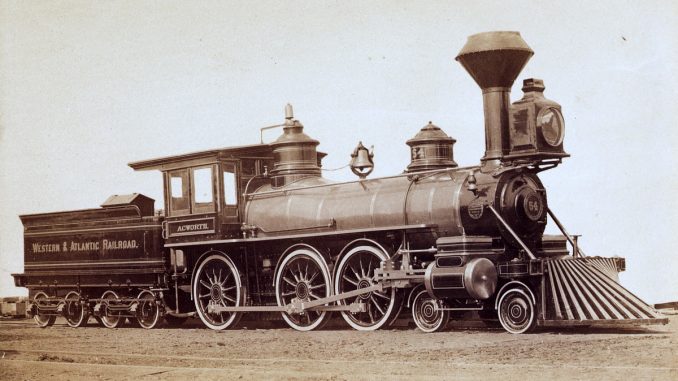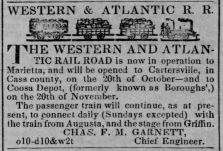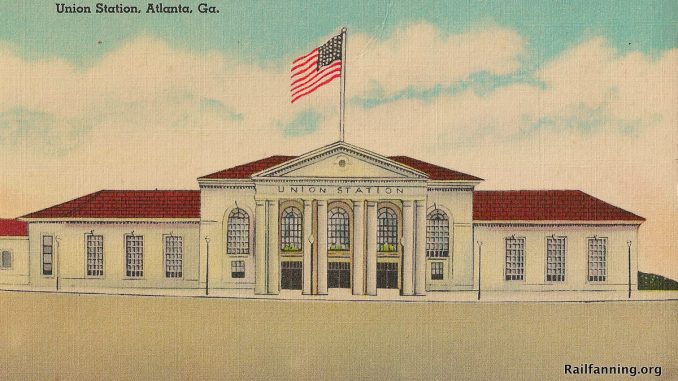
The Early Days

- Dec. 21, 1836: The Georgia state legislature incorporates the Western & Atlantic Railroad.
- July 1837: Stephen H. Long made a preliminary report to Georgia Gov. George R. Gilmer
- Dec. 24, 1842: W. F. Adair engineers the first train, running between Atlanta and Marietta, Ga. Passengers apparently expressed concerns about whether the bridge over the Chattahoochee River would support locomotive, the Florida, so they walked across the bridge rather than ride the train.
- Sept. 15, 1845: The first 22 miles of the Western & Atlantic between Atlanta and Marietta goes into operation
- Dec. 23, 1843: Terminus is incorporated as Marthasville.
- Dec. 29, 1847: Marthasville is incorporated as Atlanta.
- Oct. 31, 1849: Workers complete headings through Chetoogeta Mountain in Tunnel Hill, Ga.
- May 9, 1850: The full line between Atlanta and Chattanooga, Tenn., opens. “The stupendous monument of enterprise and skill in civil engineering … is at length completed,” the Southern Recorder newspaper of May 14, 1850, reported.
- Circa 1853: The new car shed (also known as Union Station) opened in Atlanta.
The Civil War

- April 12, 1862: The Great Locomotive Chase takes place when a group of Union spies stole the locomotive General from Big Shanty, Ga. (Kennesaw), during a scheduled breakfast stop.
- 1864: Union troops destroy the car shed in Atlanta.
Post-Civil War

- Dec. 27, 1870: A group of investors that includes former Gov. Joseph E. Brown leased the line from the state of Georgia. Brown resigned as chief justice of the Supreme Court of Georgia before submitting the bid. He was named as president of the railroad.
- 1871: The new Union Station opened in Atlanta, replacing a temporary depot the railroad used since about 1868.
- May 31-June 1, 1886: Workers regauged the railroad from 5 feet to 4 feet, 9 inches, making it compliant with the new nationwide standard gauge of 4 feet, 8-and-a-half inches.
- Dec. 27, 1890: The Nashville, Chattanooga & St. Louis Railway began leasing the line.
20th Century

- 1901: The General was placed on display at Union Depot in Chattanooga, Tenn. The General left the depot in 1927 for the Baltimore and Ohio Railroad‘s “Fair of the Iron Horse,” in 1933 for Century of Progress Exhibition in Chicago, in 1939 for the New York World’s Fair, and in 1948 for the Chicago Railroad Fair.
- Dec. 27, 1919: The Nashville, Chattanooga & St. Louis Railway renews its lease on the line for 50 years, paying a total rent of $27 million (or $45,000 per month).
- 1926: Work begins on a larger tunnel in Tunnel Hill, Ga.
- Dec. 17, 1928: A new, larger tunnel opens in Tunnel Hill, Ga.
- April 18, 1930: The new Union Station in Atlanta opened.
- 1957: The Nashville, Chattanooga & St. Louis Railway and the Louisville & Nashville Railroad merged.
- 1959: The Louisville & Nashville Railroad removed The General from Chattanooga Union Depot.
- 1969: The Georgia legislature agrees to lease the line to the Louisville & Nashville.
- April 1971: The Louisville & Nashville said it would drop three of the four passenger trains it operated, including The Georgian, which operated between St. Louis and Atlanta via Nashville.
The Modern Era
- January 1986: The Georgia General Assembly approved a new 25-year lease once the then-current lease expired in 1994. The amended lease expires on Dec. 31, 2019.
Sources
BooksNewspapersArticles
- Caldwell, Wilber W. 2001. The Courthouse and the Depot. Macon, Georgia: Mercer University Press.
- Garrett, Franklin M. 2011. Atlanta and Environs: A Chronicle of Its People and Events: Vol. 1: 1820s-1870s. Athens, Georgia: University of Georgia Press.
- Herr, Kincaid. 1964. Louisville & Nashville Railroad 1850-1963. Louisville, Kentucky: University Press of Kentucky.
- Johnston, James Houstoun. 1932. Western and Atlantic Railroad of the State of Georgia. Atlanta: Stein Printing Co.
- Klein, Maury. 1972. History of the Louisville & Nashville Railroad. New York, New York: MaxMillan Publishing Company.
- Pittinger, William. 1999. Daring & Suffering. Nashville, Tennessee: Cumberland House Publishing, Inc.
- Prince, Richard. 1968. Louisville & Nashville Steam Locomotives. Bloomington, Indiana: Indiana University Press.
- Roth, Darlene R. and Andy Ambrose. 1996. Metropolitan Frontiers. Atlanta, Georgia: Longstreet Press, Inc.
- Strickland, Justin W. 2009. Chattanooga’s Terminal Station. Charleston, South Carolina: Arcadia Publishing.
- Winn, Les R. 1995. Ghost Trains & Depots of Georgia. Chamblee: Big Shanty Publishing Company.
Historical editions of:
- The Atlanta Journal-Constitution (and predecessor publications): March 30, 2017; July 12, 2000; Dec. 24, 1999; Sept. 22, 1998; July 28, 1998; Jan. 30, 1998; Oct. 17, 1996; Feb. 29, 1996; Feb. 9, 1996; May 13, 1993; Sept. 14, 1995; June 27, 1994; May 13, 1993; Nov. 26, 1992; June 26, 1986; Nov. 27, 1985; Jan. 29, 1985; Aug. 19, 1978; Aug. 16, 1978; May 7, 1978; July 12, 1974; Sept. 10, 1972; Feb. 19, 1972; Aug. 10, 1971
- The Federal Union: Feb. 14, 1843; Dec. 5, 1848; Sept. 4, 1849; Nov. 16, 1849
- Duncan, Russell. “Rufus Bullock (1834-1907).” New Georgia Encyclopedia. 08 June 2017. Web. 04 March 2019.
- Range, Willard. “HANNIBAL I. KIMBALL.” The Georgia Historical Quarterly 29, no. 2 (1945): 47-70. http://www.jstor.org/stable/40576972.
- Stover, John F. “Georgia Railroads During the Reconstruction Years.” Railroad History, no. 134 (1976): 56-65. http://www.jstor.org/stable/43520579.
- Phillips, Ulrich Bonnell. 1906. “An American State-Owned Railroad.” Yale Review 259-282.
